
Calverley Old Hall is a medieval manor house with Grade I listed building status situated at Calverley, West Yorkshire, England. [1]

Calverley Old Hall is a medieval manor house with Grade I listed building status situated at Calverley, West Yorkshire, England. [1]
Significant portions of the house have unusually escaped alteration and modernisation in later centuries. The oldest section of the property is the solar, believed to be of 14th-century origin. The great hall, which has an interesting six-bay hammerbeam roof, and the chapel have been dated to 1485–1495. Later additions include an accommodation wing added in the early 16th century by Sir William Calverley to house his very large family.
During routine work on the Hall in 2021, color was seen beneath a small piece of plaster removed from "an undistinguished little bedroom". Further work revealed three walls covered with paintings of a very high standard in the Tudor equivalent of wallpaper, "grotesque work" based on Roman emperor Nero's Golden villa. Such painting was often painted over and destroyed, but these were preserved by being covered in plaster. [2] [3]
The Calverley family settled in Calverley in ancient times and remained for several hundred years. As landowners, the Calverleys were frequently called to military service. Sir William Calverley (died 1506) was summononed to fight Perkin Warbeck's army in Cornwall in September 1497. [4] Walter Calverley (1483-1536), was knighted at Lille in October 1513 following the battle of the Spurs. [5] His son, William Calverley, captured the Scottish laird of Orchardton at the battle of Solway Moss in 1542, [6] and provided 20 soldiers and served as a captain in the campaign in Scotland in 1544. [7]
The hall was witness to dreadful violence in April 1605, when Walter Calverley murdered two of his sons, William and Walter, after drinking heavily. [8] He was tried in York for murder but refused to plead and was therefore pressed to death. Because of his refusal his property could not be seized by the state and passed to his surviving baby son, Henry. [9] The case inspired two Jacobean plays:
In the mid-17th century, Walter Calverley (b. 1629) married Francis Thompson, heiress of the Thompson estate at Esholt. In 1709 their son, Walter, built a new mansion house on the site of Esholt Priory and the family left Calverley. After he died in 1749 the family sold the Esholt estate and in 1754 sold the Calverley properties to the Thornhills. Thereafter the hall remained under a single landlord but was subdivided into cottages. The chapel was let out as a wheelwright's shop.
In 1981 the Landmark Trust bought the property and converted a 17th-century block for use as holiday accommodation. Full restoration of the site, including the great hall and solar wing, has been a long-term project because of life tenancies. Meanwhile, part of the site is deemed to be heritage at risk, subject to gradual decay pending completion of the restoration. The Trust aims to provide space for community use as well as holiday accommodation. [11] [2]
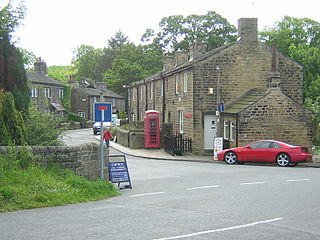
Esholt is a village and former civil parish in the metropolitan district of the City of Bradford, West Yorkshire, England. It is situated 3 miles (4.8 km) east of Shipley town centre, 1.5 miles (2.4 km) south-west of the A65 in Guiseley, 7 miles (11 km) north of Bradford City Centre, and 10 miles (16 km) north-west of Millennium Square, Leeds.

Temple Newsam is a Tudor-Jacobean house in Leeds, West Yorkshire, England, with grounds landscaped by Capability Brown.


Allerton Castle, also known as Allerton Park, is a Grade I listed nineteenth-century Gothic or Victorian Gothic house at Allerton Mauleverer in North Yorkshire, England. It was rebuilt by architect George Martin, of Baker Street, London in 1843–53.

Wallington is a country house and gardens located about 12 miles (19 km) west of Morpeth, Northumberland, England, near the village of Cambo. It has been owned by the National Trust since 1942, after it was donated complete with the estate and farms by Sir Charles Philips Trevelyan, the first donation of its kind. It is a Grade I listed building. Some of the wealth of the Trevelyan family derived from the holding of slaves in Grenada.
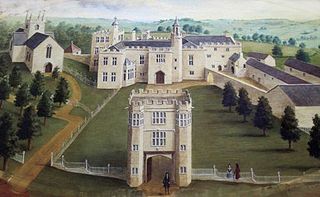
Old Shute House, located at Shute, near Colyton, Axminster, Devon, is the remnant of a mediaeval manor house with Tudor additions, under the ownership of the National Trust. It was given a Grade I listing on 14 December 1955. It is one of the most important non-fortified manor houses of the Middle Ages still in existence. It was built about 1380 as a hall house and was greatly expanded in the late 16th century and partly demolished in 1785. The original 14th-century house survives, although much altered.

Helmsley Castle is a medieval castle situated in the market town of Helmsley, within the North York Moors National Park, North Yorkshire, England.

Calverley is a village in the City of Leeds metropolitan borough in West Yorkshire, England, on the A657 road, about ten miles (16 km) from Leeds city centre and four miles (7 km) from Bradford, and lying north of the town of Pudsey. The population of Calverley in 2011 was 4,328. It is part of the City of Leeds ward Calverley and Farsley, with a population of 22,594 at the 2011 Census.
Gilling Castle is a Grade I listed country house near Gilling East, North Yorkshire, England.
Harewood Castle is a 14th-century stone hall house and courtyard fortress, located on the Harewood Estate, Harewood, in West Yorkshire, England. Harewood Castle is a grade I listed building.
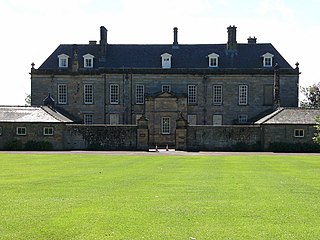
Sir Walter Calverley Blackett, 2nd Baronet was a British baronet and politician who sat in the House of Commons from 1734 to 1777.
Sir Walter Calverley, 1st Baronet was an English aristocrat.


Norbury Manor is a 15th-century Elizabethan manor house and the adjoining 13th-century stone-built medieval hall house, Norbury Hall, known as The Old Manor in Norbury near Ashbourne, Derbyshire. It is a Grade I listed building.
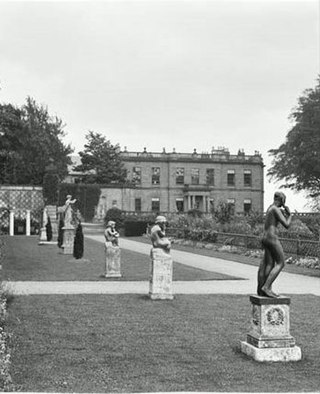
Windlestone Hall is a mid-16th century Elizabethan country house, heavily rebuilt in 1821 to form a Greek revival stately home, situated near Rushyford, County Durham, England. The Hall sits within 400 acres of designed parkland. It is a Grade II* Listed building. As of 2022 it is back in private family ownership, with the surrounding estate maintained and conserved by a dedicated heritage charitable trust.
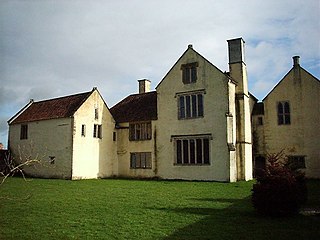
Gurney Manor in Cannington, Somerset, England is a 13th-century manor house with an attached chapel wing. It is now supported by the Landmark Trust and is available as holiday accommodation. It has been designated as a Grade I listed building and is considered notable partly due to the substantial survival of medieval construction throughout.

Esholt Priory was a Cistercian priory in West Yorkshire, England which was sold after the Dissolution of the Monasteries, and the present Grade II* listed Esholt Hall now stands on the site of the priory.

Walter Calverley was an English squire from Yorkshire.

Dean Incent's House is a 15th-century timber-framed house in Berkhamsted, Hertfordshire, England. It is reputed to be the birthplace of John Incent, a dean in the Church of England who held office at St Paul's Cathedral from 1540 to 1545.
Thornhill Hall is a ruined medieval manor house on a moated island located in Rectory Park, Thornhill, West Yorkshire, England. The ruins are listed as grade II. and the moat, with the surrounding grounds, is a scheduled monument.